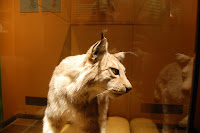If one follows the intended path through the museum, instead of scooting to whatever exhibit strikes one's fancy as I did, this is the last of the thematic exhibit areas.
The focus here is clearly regional, emphasising the specific nature of the province of Limburg. The first part is preoccupied with unusual species; wolves, lynxes and boars. These are clearly the biggest attention grabbers, but there are some nice displays in the current nature section as well.
The Lynx is a recent arrival, tracks have been found on a regular basis since 1985 but there is no evidence that lynxes have settled in the Netherlands. The wolf on the other hand is a past inhabitant, having lived here until the 19th century.
It should be noted that the wolf display showing it running off with a piece of children's clothing is rather unfair.
The boar family in the top picture is also the brunt of historical prejudice, the stone plaque commemorates the killing of boars that after a long absence had returned to the vicinity of Maastricht (the return of "the hated enemy").
The section is rounded out by two flying species, the enormous Sea Eagle and the minute Common Pipestrelle. The pipestrelle is the odd one out since it is not uncommon in Limburg, but it has somewhat amusingly been pinned to a textbook describing the species.
The Sea Eagle (also commonly known as the white-tailed eagle) literally dwarfs the bats, it is the largest European eagle and it's size and broad wings have earned it the nickname 'Flying Door'. It has long been extinct in the Netherlands, appearing only as an occasional visitor. but may be returning as two breeding pairs have formed nests in recent years.
This section of the Natural History Museum Maastricht has some very nice taxidermy, with mounts that show active poses and are very life-like. It also has a lot of white space, which works will in some places by making the rather small area seem slightly less crowded. But especially towards the end it also creates a feeling of emptiness, for example that eagle is just hanging there in limbo.
Some of that white (or orange) space would have been better devoted to tying the disparate displays together, and giving a better sense of theme.





Hello i am kavin, its my first occasion to commenting
ReplyDeleteanywhere, when i read this article i thought i could also create comment due to this brilliant post.
Review my website: cheap desks 2012